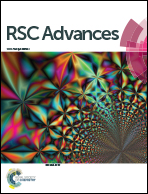Multifunctional bio carbon: a coir pith waste derived electrode for extensive energy storage device applications†
Abstract
As a sequel to our earlier findings on the suitability of coir pith derived carbon (CPC) in lithium-ion and lithium sulfur batteries, the extended suitability of CPC electrode for sodium-ion batteries (SIBs) and electrical double layer capacitors (EDLCs) has been demonstrated through the present work. Herein, the activation temperature of CPC plays a vital role and an optimum temperature of 850 °C is found to be essential to demonstrate superior electrochemical performance in sodium-ion batteries and the product is denoted as CPC-850. An initial capacity of 280 mA h g−1 and a progressive capacity of 220 mA h g−1 up to 300 cycles with negligible capacity fading have been observed at 50 mA g−1. Furthermore, CPC-850 delivers ∼110 mA h g−1 for 1000 cycles at 1 A g−1 and demonstrates tolerance up to 5 A g−1, corresponding to 13.44C rate. In EDLCs, a CPC-850 symmetric cell exhibits 191 F g−1 at 0.1 A g−1 current density. Notably, CPC-850//CPC-850 withstands rated currents such as 1, 2, 5 and 10 A g−1 and delivers 168, 152, 150 and 128 F g−1 up to 10 000 cycles. Hence, the multifunctional capability and versatile suitability of the CPC electrode in electrochemical energy storage devices could be understood.



 Please wait while we load your content...
Please wait while we load your content...